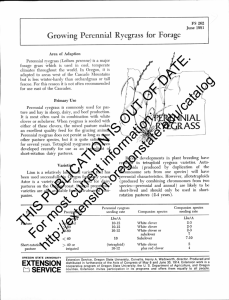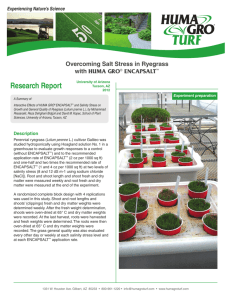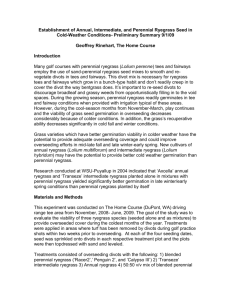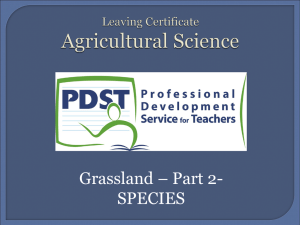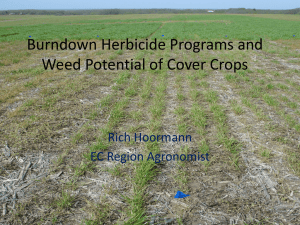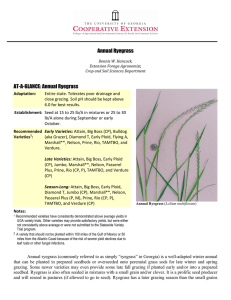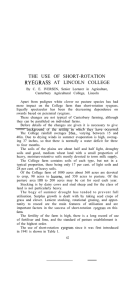h THE VALUE OF STRAINS OF RYEGRASS IN CANTERWRY.
advertisement
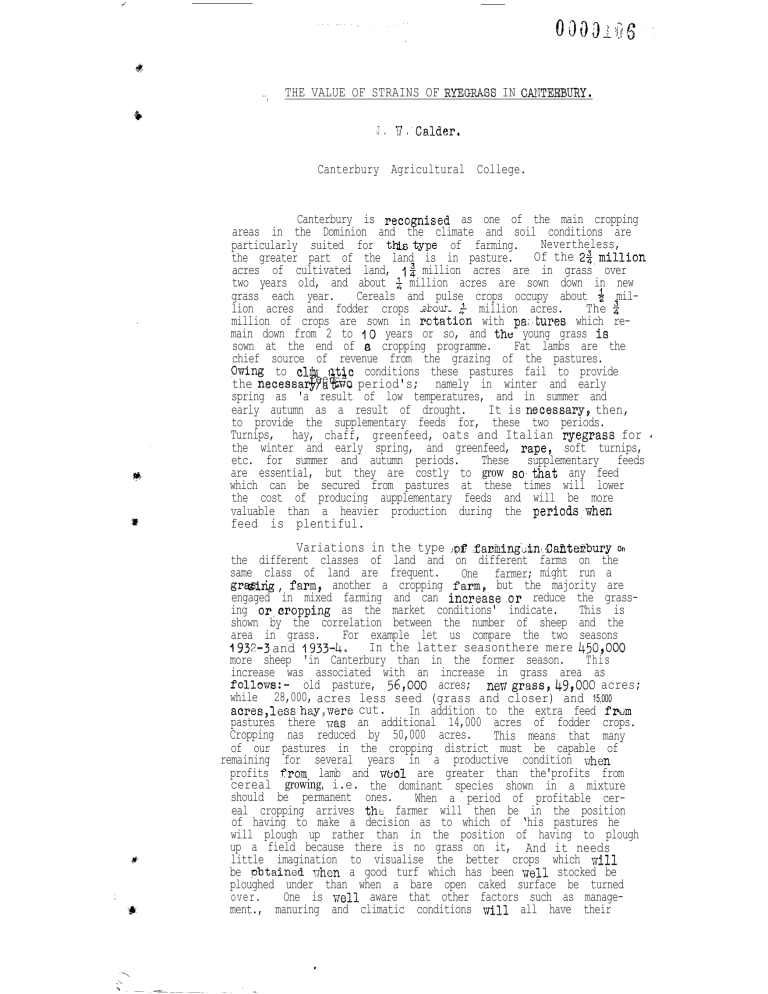
h “, THE VALUE OF STRAINS OF RYEGRASS IN CANTERWRY. J . ?'? . ‘Calder. Canterbury Agricultural College. Canterbury is recognised as one of the main cropping areas in the Dominion and the climate and soil conditions are Nevertheless, particularly suited for tkdstype of farming. Of the 2$,million the greater part of the land is in pasture. acres of cultivated land, -j$ million acres are in grass over two years old, and about $ million acres are sown down in new grass each year. Cereals and pulse crops occupy about 6 million acres and fodder crops about 1 million acres. The 9 million of crops are sown in rotati& with pa;.tures which remain down from 2 to 10 years or so, and the young grass is sown at the end of a cropping programme. Fat lambs are the chief source of revenue from the grazing of the pastures. Cwing to clil at',c conditions these pastures fail to provide the necessar P,%? 4two period's; namely in winter and early spring as 'a result of low temperatures, and in summer and early autumn as a result of drought. It is necessary9 then, to provide the supplementary feeds for, these two periods. Turnips, hay, chaff, greenfeed, oats and Italian ryegrass for the winter and early spring, and greenfeed, rape9 soft turnips, etc. for summer and autumn periods. These supplementary feeds are essential, but they are costly to grow so,that any feed which can be secured from pastures at these times will lower the cost of producing aupplementary feeds and will be more valuable than a heavier production during the periods,when feed is plentiful. Variations in the type ;q$? .f:ac~ing:;2n(Gal?lte~bury On the different classes of land and on different farms on the same class of land are frequent. One farmer; might run a farm? another a cropping farm9 but the majority are grmirig , engaged in mixed farming and can increase.or reduce the grassing or,sropping as the market conditions' indicate. This is shown by the correlation between the number of sheep and the area in grass. For example let us compare the two seasons In the latter seasonthere mere 450,000 1932-3 and j933-4. more sheep 'in Canterbury than in the former season. This increase was associated with an increase in grass area as follovJs:- old pasture, 5G9000 acres; new grass9 49pOO0 acres; while 28,000, acres less seed (grass and closer) and 15,000 acres,less hay,were cut. In addition to the extra feed frtim pastures there eras an additional 14,000 acres of fodder crops. Cropping nas reduced by 50,000 acres. This means that many of our pastures in the cropping district must be capable of remaining for several years in a productive condition vrhen profits from lamb and vrclol are greater than the'profits from cereal growing, i.e. the dominant species shown in a mixture should be permanent ones. When a period of profitable cereal cropping arrives thk farmer will then be in the position of having to make a decision as to which of ‘his pastures he will plough up rather than in the position of having to plough up a field because there is no grass on it, And it needs little imagination to visualise the better crops which nil1 be pbtained nhen a good turf which has been nell stocked be ploughed under than when a bare open caked surface be turned over. One is vrell aware that other factors such as management., manuring and climatic conditions will all have their i.. -. = effect,,in making a good pasture, but unless the foundation pasture perennial plankis there, a satisfactory long ,liv.ed cannot be secured. * Perennial ryegrass can o'ccupy the dominant position in most permanent pastures on the medium and better soils where it persists and its pro.duction is influenced by rainfall and management. It shoots to seed readily.on the approach of dry weather and remains in a dormant state until conditions again favour gronth. On the light,plains it dees not satisfy the requirements of a permanent pasture after the .relative high fertility associated with fodder crops and cultivation has reached normal in trio or three years. The rapidity with which these soils dry out and their low moisture,holdi,ng capacity make conditions too severe for permanent productive ryegrass pastures. For long term pastures on this class of land cocksfoot should form the dominant constituent in the mixture. It is at this stage that the question of "strain" in perennial ryegrass can be introduced. Some years ago it was the general experience that perennial ryegrass would not hold for more than a year or two on many areas in Canterbury, Dr. Hilge.:+crf, when he commenced vJork on grasses9 drew attention to th.? fact that, in Canterbury, it was not so much perennial ryegrass that was at fault, but the strain of ryegrass used. He grew plots of the ordinary commercial ryegrass alofgside plots of ryegrass harvested from a field which had been in grass from 45 to 50 years9 and at the end of two years about 90 per cent of the plants from commercial seed and 5 or 6 per cent of the plants .from the old pasture had died, Mr. Levy, at Palmerston North, grew a comprehensive series of commercial lines of ryegrass from throughout New Zealand and he showed that the only lines of true perennial t-Thich were being harvested and sold on the market wame from old pastures in non-cropping areas9 chiefly.from Hawkes Bay, with the result that these lines now occupy the predominating position in the Department's Certification Scheme which was started as a result of these trials. , V/hat is the origin of these temporary strains? Among the crops that are frequently.gronn in Canterbury is Italian ryegrass. Sown in summer orearly autumn, it provides valuable autumn,;cr-ri?iter and spring greenfeed for ewes and l=ambs when pastures are dormant. After the flush'of other feed arrives it is shut up for seed. From -40~15,000 acres of Italian ryegrnss are so used each year. This, in itself, would probably not have been detrimental to the perennial strain of ryegrass, but in addition to its use asa fodder crop, a small ‘amount of Italian was often included in the rotation pasture mixture with the object of providing the valuable winter and early spring grazing, These-pasture mixtures were predominantly perennial ryegrass and, when conThe seed ditions warranted, they were shut up for seed. crop, especially in the first year9 would contain a percentage of Italian ryegrass in it. If this mixture were only 8 , mechanical one, and was purch::sed with thi& knowledge, no harm would result, but experimental work h&s shown that the two species, Italian and prennial ryegrass, are readily cross pollinated, with the result that, in:addition to a mechanical mixture, ne get a biological mixtur,o. Frequently this complex mixture was sold as perennial and was included ,in a pasture mixture together with a bit more Italian, and so the process went.on for some'generations until -many,of the lines were predominantly Italian or Italian hybrids. They mere temporary in nature ,and contained a'small'percentage of perennial plants according to the number of generations that they were exposed 'to Italian contamination. THE VALUE OF STRAIN IN RYEGRASS. ? In thMrst place true perennial ryegrass is long lilv=d under a m range of soil and management conditions and should form the basis of mixtures for the r,otation pastures of from 2 to 90 years or so on medium to better class soils. The temporary strain thins out after the first year or t\vo and low,production grasses such as browntop, sweet vernal, fog or Danthonia establish... on the bare spaces and soon gain possession, T,he widespread occurrence of these and other pasture weeds on many areas of cultivated land is mute testimony of the temporary nature of the sown specie-s. The temporary s t&ins, owing to thair Italian "blood," produce earlier and ‘more. palatable gra=ing, and this superiority mcay last for a few months; but after the first autumn, a high perdentage of the plants die, so the strain is notat, all suited for t;;..., long term pastures. For onk or two years.grnzihg-* on all soil types supplying the autumn, ninter and spr1n.g periods, the Italian and red clover mixture is supreme. The occupation of the sward by‘the true perennial ryegrass under good management gives a higher carrying capacity than a snard,dominatod by the low producing, but long lined browntop and Danthonia, and this in turn means higher fertility !?hen tne pasture is hroken up for a period of cropping. The treatment which perennial rye gets is responsible for its b.ehavour and m,any pastures are ruined by overgraming at critical periods, This applies particularly to the pastures of thd light shingly plains, During dry periods the perennial rye dries up or shoots to seed and unless there are supplementary feeds available, the pastures are~of necessity, heavily punished by overgrC~i&.; This period of overgr,cla.ring; during drought weakens the plants and those that do not die are unable to grow vigorously nhon- conditions do favour growth, The question of,pZatability has been promintit in reference to the perennial ryegrass. There is no question that it is less palatable than .Italian or than the "mixture? ,vfith which it has so often been compared to its disadvantage, When badly managed, the. unpalatable nature can be so emphasised that sheep will not eat it and go back in condition. Under good management, however, it forms the basis of a palatable pasture on which sheep thrive, Most of'the criticism against perennial ryegrnss has fallenon thase pastures which were sown with pure ryegrass for seed purposes, those which had become rank before grazi:ig,, W* khose which had been cut for Another condition which seed and the dry-aftermath graz&$, , accentuated the unpalatable nature alas ,the practice in cropping farms of sowing the grass in the autumn after one or two cereal crops-. Under these conditions the fertility is relatively low, the soil is dry and the til(.his poor0 with the result that autumn growth of grass is slow, and the This pasture will remain plants are fibrous and lack vigour. poor and unpalatable for two or three years, while one Sown on a fertile and no11 prepared seed bed will be high :Troducing right from the start. Palatability is important for9 after all, the feed is grown for the stock and they eat less of an unpalatable food and consequently do not thrive6 Therefore, every effort should be made tolkeep the grass as palatable as possible by sowing suitabie,mixtures, by grazing _ reasonably short and by sowing under high fertility conditions. i@ fv J There is anothtir fr,ctor which must be taketi into consideration and that %s the effect of competition of perP e r ennial rye on its associate plants in the mixture, ennial ryegrass is tin 0. essive plant, not only in the first year when it is severe, $u t also in succeeding years to a less extent. This mession is the result of its relative rnp$d.. growth on a cultivated seed bed, its strong,groal;hunder 3. t 6oki.n~89 I-- .I and the thickness, of seeding which is usu~.lly applied. It thus compc%es with other plants in the mixture cocksfoot, red clover and white clover, which are slowo to establish, The effects of this,conpetition are not SO marked when the :lixture .has, been sovm in Noveinber, 3ccenber ‘or January, because the slonor established plants, though checked, are not killed and after some autumn grazih& and dry nenther has chetiked the ryegrass, they nre enabled to become sufficiently well established to survive the winter and later contribute to the feed supply. When, however, the rdxture is sonn.in late February, March or April, as is commonly done in ;cropping arms 9 the checking of the cocksf'oot and cl'overs is responsible for th3 slog development and the, ClOvei'S are hardly out of the three leaf, stage and the cocksfoots are only small plants when the frosts cdme, In this stage they are subj6c.t to frost lift, more expecinlly vfhen the ground is wet. In order to make conditions as fnvourable as possible for'the,other pl?.nts sown in n mixture with perennial ry'egrass, early sowing should be practised and the young pnstures should be judiciously grazed1 to prevent a smothering gronth of ryegrass. CONCLUSION: The true perennial ryegrass strain is R long 11x&d perennial and should form:the basis of all long tern pqsture.nixtures ,on nil but the lightes soil types,, while the tenporary type, ahich,is no at all but a hybrid mixture9 is short liled, and omitted from all long term pastures, There is a. difference in palatability between the two, but the lower palatability 'of the true perenniclIh can be minimised by aowing well proportioned mixtures9 by -encouraging rapid growth and by keeping the grass grazed.& to prevent it becoming tough or fibrous. The severe competitio c erted by perennial rye is responsible 2?or R deficiency of fii33s plqnts in a pasture.but this can ,. be minimised by enrly sowing and by grazing to prevent the ryegrass developing a smothering grdath,
